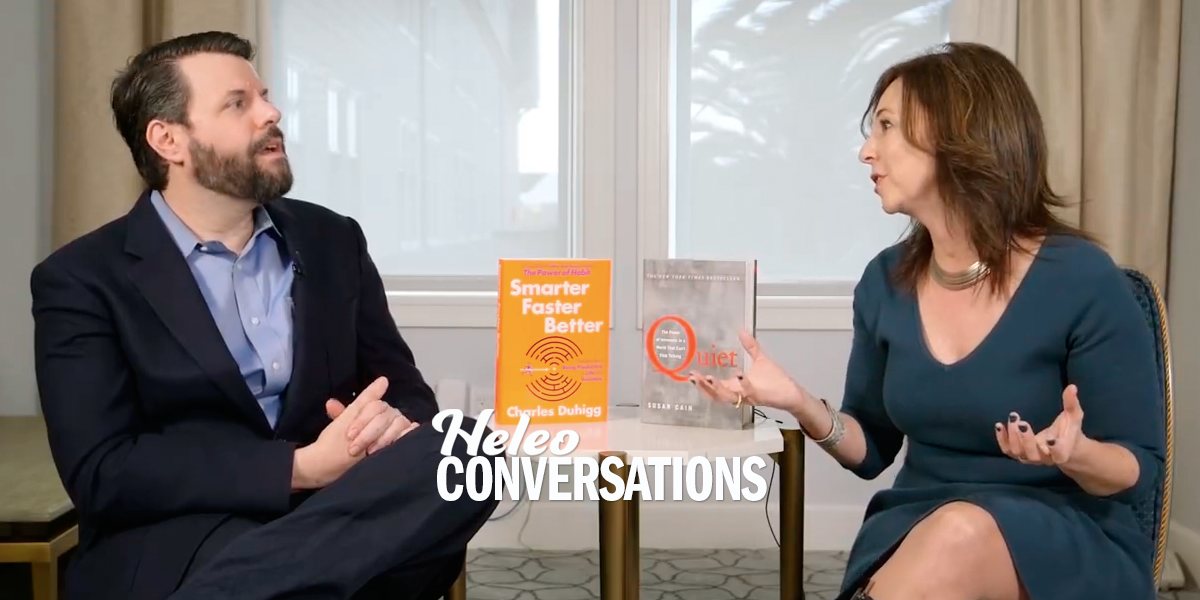In a culture that prizes charisma and confidence, Susan Cain, author of Quiet: The Power of Introverts, advocates for those who prefer quiet at work, at school, and at home. Susan recently sat down with Charles Duhigg, author of Smarter Faster Better and The Power of Habit to talk about the introvert revolution spurred by Susan’s work. Read on to learn about what really makes someone an introvert, the ways bosses and parents can cater to the introverts under their wing, and how Charles’ research on productivity and habits intersects with Susan’s mission to give introverts a voice.
Charles: Let’s start by talking about introverts. There’s been this revolution sparked by your book in terms of understanding what introverts are, how many of us are introverts. If I was trying to figure out “who is an introvert?,” help me with that.
Susan: When you say the word ‘introvert,’ we imagine we’re talking about some marginal segment of the population living off in a shack in the woods. But we’re really talking about half the population according to most recent studies. It’s a lot of people. We don’t usually think of it that way because introverts are so skilled at acting more extroverted than we really are. We’ve been taught to do that from early as childhood.
Charles: What exactly is an introvert then? If it’s half the population–and I think we’re trained to think of introverts as shy people who never come out of their shell–what is an introvert?
Susan: A lot of people have heard the idea that introverts get their energy from being on their own, so they can be just as socially skilled as anybody else but really need to go off in order to recharge their battery; in contrast to an extrovert who really does recharge by being with other people. That’s a really useful metaphor but it’s just a metaphor for what’s happening neurobiologically. That fact is introverts and extroverts have different nervous systems.
Charles: That’s interesting. If I’m an introvert, how do I differ from an extrovert neurobiologically?
Susan: Your nervous system would be more reactive to stimulation of all kinds, social stimulation like a big party where you have to navigate all kinds of social cues coming in at you. It’s also lots of light, lots of noise, just hubbub in your environment. You’re going to react more, which means that your sweet spot is usually in a quieter place where there’s less going on.
Charles: If I’m an introvert, can I have the same life as an extrovert as long as I change my environment to accommodate that? What’s the takeaway once I know that I’m an introvert? What should I do?
Susan: It’s two things. By the way, this applies equally to extroverts who sometimes find themselves in environments that don’t suit them, because extroverts need more going on to feel in their sweet spots. One is becoming aware enough that you start to mindfully tailor your environment so that you operate in your sweet spot as much of the time as you can and feel entitled to do that. Two is the more mindful you become about this stuff, the more you can consciously, purposefully step outside your comfort zone in order to accomplish the goals you want in this world. When you’ve done that, you restore the niche where you really get to be yourself. You’re in equilibrium.
Trending: How to Transform Daily Habits into Life-Changing Rituals
Charles: This is fascinating because one of the things that came up again and again when I was writing the book about productivity was people saying workplaces have to become fundamentally different. It has to accommodate the different types of workers there instead of treating everyone as one kind of worker.
If I’m running a huge company, if I’m AT&T and I have hundreds and thousands of employees, how do I take this and make it into something tangible?
Susan: The first thing you need is a shift in mindset. We talk about diversity all the time but I don’t think companies tend to be aware of diversity of nervous systems. The fact is that there is not a one-size-fits-all environment, as you’re saying.
One person needs an office where they’ve got lots of stimulation coming at them. Another person needs space that is quieter. The more you can design an office that has varied amounts of space with each individual, having the option to move back and forth between private and social spaces, the more you have each person operating at their best.
I have seen a lot of value come from making it socially acceptable to discuss these differences instead of it being a conversation that’s weird or idiosyncratic to have. Just put it all out on the table. Everyone can talk about their differences.
Charles: What this reminds me of is the research on teens and the concept of psychological safety. When I was talking to researchers about it, one of the most important things they said is, “When we say psychological safety, people tend to focus on the safety part like everyone feels safe. But it’s not actually that necessarily everyone feels safe, it’s that they can feel safe to acknowledge that they are safe or aren’t safe.” Having the conversation, in some ways, is more important than what comes after the conversation, just being able to acknowledge these issues.
Susan: That’s right. Developing a vernacular where everyone can talk about that in a playful, light-hearted way that isn’t this big loaded thing. There’s no way to overestimate how big a deal that is.
Charles: If I’m a manager and I have employees who say ‘I’m an introvert’ or who I believe are introverts or who I think need more time on their own, what should I do to empower them? Is it really just as simple as saying, “Go ahead and take the half hour for yourself after lunch,” or do I need to do something deeper?
Susan: It’s opening up conversations and then it’s thinking deeply about questions like meetings and paying attention to who is contributing.
Charles: How would I manage a meeting differently if I have a room full of introverts versus extroverts or a mix?
Susan: There’s research indicating that mixes, what I call a yin and yang, are the most effective because introverts and extroverts are actually attracted to each other as peers, as colleagues, as friends. There’s an instinctive sense of, “We each bring different things to the table here. We’re complementary.” What’s worth figuring out is how do I get these people together that work well.
Charles: If I’m leading that meeting though, what do I do? What do I do for the introverts and the extroverts?
Susan: There are all kinds of things. The first is not having as many meetings in the first place because you’re probably not ever going to get the best of an introvert’s brain in a meeting and it’s useful to acknowledge that right upfront.
Trending: 5 Reasons Life Gets Better After Your 40s
It’s also helpful to make sure you’re letting people know in advance what it is you’re going to be talking about. If you have an introvert who you know has a lot to say about a particular issue but tends not to say much at meetings, let them know in advance that you’d like them to talk about that XYZ. It’s also useful to use different techniques.
Research shows that in your typical meeting, three people do 70 percent of the talking. There’s a giant disconnect between what we should be doing and what we are doing.
There’s a think-pair-share technique that we use a lot when we’re running meetings. Instead of making it a big, open free-for-all with everybody talking to get their point in, you present an issue, you have people think about it on their own for a moment and then you ask people to break up into pairs, talk about it with their partner and then ask the partners to share out to the larger group.
It gets people to comfortably articulate the ideas inside their head to only one other person. From there, it’s an easier leap to get it out to everyone.
Charles: That’s fascinating. I don’t think most people think about meetings as something that they need to think about the process of the conversation.
Susan: It’s so funny that people don’t think about this. As you said in your book, the best performing teams are the ones where everybody is contributing an equal amount. Yet there’s research out of the Kellogg School recently that showed that in your typical meeting, you have three people doing 70 percent of the talking. There’s this giant disconnect between what we should be doing and what we are doing.
Charles: Think-share-pair. That’s really interesting. That’s from a manager. Let’s say that I am an employee myself who is an introvert and I am struggling with an environment where my boss hasn’t necessarily read your book. How do I have that conversation in a way that doesn’t make me seem like I’m a weak employee?
Susan: This is a tricky thing. Honestly, you really do have to gauge who you’re talking to because there are some bosses who are going to get it and be open to a conversation like that where you’re really putting the cards right out there on the table and others where that’s only going to happen through a mediated process. You have to acknowledge that.
No matter who you’re talking to, it’s useful to frame the conversation in terms of a career path, ‘How can I contribute to this company?’ and ‘Here’s where I want to be five years down the road, how can you help me get there?’
Charles: How do I explain I’m an introvert in a way that doesn’t say ‘I’m weak?’
Susan: A lot of it is tying your preferences for how you like to work to the contributions you’ve made. If you can say, ‘You know what? I was on this last project. I was able to carve out three hours a day of focus time where I was in a state of flow with no interruptions and here’s the benefit that it lead to.’
Charles: That’s fascinating. There’s a chapter in Smarter, Faster, Better about focus. One of the big takeaways is that if you have a mental model, it helps you subconsciously distinguish between what you should pay attention to and what you should ignore. This plays perfectly into that because being able to elucidate my mental model is dependent upon not having a bunch of distractions. It seems more powerful to say that than to say, “I really don’t like it when people bother me all the time.”
Whatever you think and feel in your heart is going to communicate itself no matter what you say or do.
Susan: Exactly. So much of it is just in how you frame the whole thing. In fact, we all benefit from flow and focus and not being interrupted. There’s a mountain of research showing that it’s better for everybody. Every time you’re interrupted, the task takes you twice as much time to complete it. Introverts are more conscious of the need for it but we all benefit from it. At Quiet Revolution, we’ve actually adopted a practice of no meetings in the mornings.
Charles: Interesting. Because you find that it disrupts people’s focus and flow?
Trending: 5 Simple Strategies for Persuading Anybody
Susan: Yes, just the whole idea is being able to give people that sense of freedom that I wake up in the morning and I know I’ve got the morning free to really focus. We’re realists so of course there are exceptions, especially if we’re meeting with a client or something like that. In general, we try to honor that policy.
Charles: Let me ask you about one other application of this. If I’m a parent and I have children who are introverts and I want to arm them for the world — because I might love that they’re introverts, but we all know that sometimes the world is a harder place for our kids than we wish it was — what do I do to train them? What do I tell them in order to give them the tools to succeed?
Susan: This is a gigantic question. More than I can get out in one quick answer. Again, first of all, mindset shift. You’ve got to truly think of your child as super cool and full of super strength because this is true life in general. Whatever you think and feel in your heart is going to communicate itself no matter what you say or do. The first thing you’ve got to do is own your mindset.
It’s also recognizing that quiet kids tend to have a longer runway before they take off and fly. They are going to take off and fly just the way all kids do but they need to know that you’re with them on that long runway. For example, if you have a child who is uncomfortable with learning how to swim, the answer is not to just throw them in the pool and ignore their fear.
It’s also not saying, “You don’t want to swim, you don’t have to learn.” It’s instead saying, “Okay. You know what? Why don’t we take you to the pool on a day when it’s quiet, there’s no one else there and we’re just going to learn one on one and splash around?” You do that step by step by step. Eventually, you can’t tell that kid apart from the one who splashed into the water on day one.
(This conversation has been edited for clarity)




























